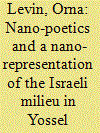| Srl | Item |
| 1 |
ID:
177746


|
|
|
|
|
| Summary/Abstract |
This article discusses the unique nano-poetics and its nano-representation of the Israeli milieu, as found in Yossel Birstein’s short-short bus-stories. While these stories demonstrate the author’s poetics, they also constitute a miniature replica of Israeli society, emphasising the following four major aspects of this society: (1) the tension between the Jewish past and the Israeli present; (2) the complex dynamics between private and public life; (3) the gap between newcomers and veteran immigrants; and (4) a mentality dominated by nervous tension combined with the unique form of audacity known as chutzpah. Birstein presents the bus both as the inspiration for and as the object of his writing, and this narrative framework showcases the many variants in Israeli culture.
|
|
|
|
|
|
|
|
|
|
|
|
|
|
|
|
| 2 |
ID:
164326


|
|
|
|
|
| Summary/Abstract |
Dorit Feldman is a prolific Israeli artist who over the course of several decades has focused on images of wide landscapes that integrate geological, cartographical, and archeological layers.Amongst these stratified landscapes are scattered pagan images such as Classical architecture, the remains of ancient synagogues, the image known as the “Mona Lisa” from Sepphoris, and a thick book that arouses connotations to the Bible or to history in general. The basic assumption underlying this study is that the analysis of a contemporary work of art that combines ancient images and motifs requires an initial analysis of their original significances. This in turn leads to a discussion of their metaphorical meanings in relation to the modern-day experience. In the case of Feldman's works, the issues that arise are those of the relationship between religion, land, and a place; idolatry in Antiquity and its current manifestations; the significances of pagan images in a Jewish context in Antiquity in relation to contemporary Epicureanism; secular Judaism and religion; and the multilayered pluralism of Israeli culture. This study is anchored in the wider field of Classical reception studies, and thus incorporates ancient sources and research material on Antiquity as well as the contemporary experience.
|
|
|
|
|
|
|
|
|
|
|
|
|
|
|
|